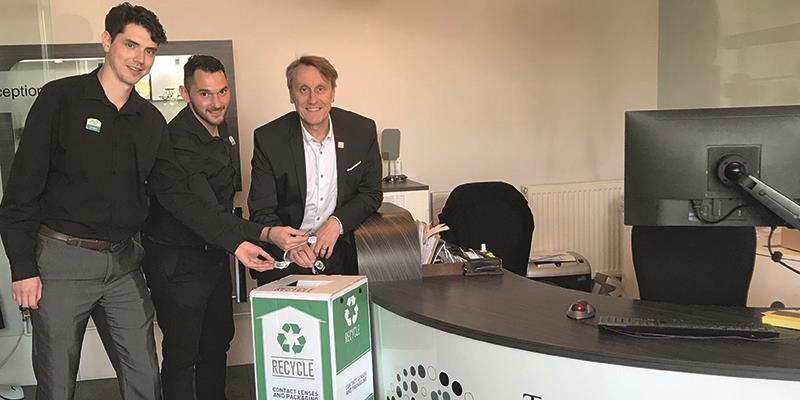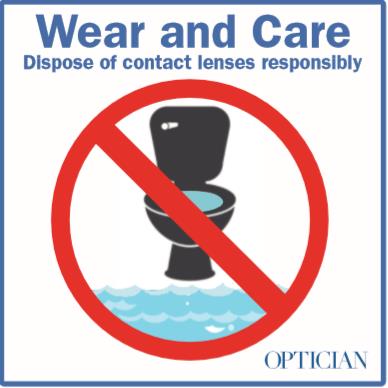Arecent study by Arizona State University in the USA has highlighted that 19% of contact lens users regularly flush their lenses down a drain, which has increasingly added to plastic pollution in oceans and rivers. This has amounted to 20 to 23 metric tons of wastewater-borne plastics every year. The research team discovered lenses can end up being consumed by marine life, running the risk of eventually being present in food eaten by humans.
During the study, scientists looked at a total of 13 different contact lens brands made from nine types of plastic polymers. They observed the lenses travelling through the waste water system and saw their structural strength break down and the smaller plastic particles turn into tiny microplastics. These can end up in surface waters where they can accumulate and pollute the environment.
Rolf Halden, director of the Biodesign Institute’s Centre for Environmental Health Engineering at ASU, said: ‘A simple first step would be for manufacturers to provide on product packaging, information on how to properly dispose of contact lenses, which is simply by placing them in the trash with other solid waste. A desirable long-term outcome would be to create lenses from polymers that are fine-tuned to be inert during use but labile and degradable when escaping into the environment.’
Approximately 4.2 million people in the UK wear contact lenses, so recycling both the lenses and the accompanying materials could potentially have a significant impact on pollution and waste levels.
Making a difference
A practice in Northamptonshire has recently become one of the first in the country to offer patients a complete recycling service for contact lenses in order to fight against single-use plastics. Tompkins Knight & Son Optometrists has been urging all of its patients to take advantage of this new service, which has involved blister packs, packaging and some contact lenses being sent away to be recycled. The team have set up a recycling station in the reception area of the practice, so patients can use it to drop off their used packaging, so it is recycled and avoids landfill.

Tompkins Knight & Son Optometrists
Practice owner Brian Tompkins said: ‘Plastic is the scourge of the planet right now, polluting our oceans and having a huge detrimental impact on the environment. Introducing a contact lens recycling service is a small but vital step in the global war against single-use plastics. It’s a game-changer. It is open to anyone, not just our patients. We are urging all contact lens users in and around Northampton to drop off their lenses and packaging and we will do the rest to ensure they don’t simply get thrown away. By recycling these materials, we can help give them a new lease of life rather than adding to the mountain of single-use plastic clogging up our planet.’
Contact lens manufacturer Bausch+Lomb has set up its own recycling scheme, which is sponsored by TerraCycle. American contact lens wearers interested can recycle used blister packs, top foil and contact lenses by placing them in a cardboard box, printing out a free shipping label and take the box to a UPS drop off location. Alternatively, the practices themselves can become an official recycling centre, so the used lenses can be taken to a participating opticians practice to be recycled. Benefits available for practices include receiving free promotion kits to advertise this and for every qualifying shipment of lenses, a $1 donation will be made to Optometry Giving Sight.
The British Contact Lens Association (BCLA) believes there is much that can be done to prevent people from disposing of contact lenses down drains.
Cheryl Donnelly, chief executive of the BCLA, said: ‘Encouraging contact lens wearers to recycle their packaging and blister packs would go a long way to help the situation, but we also need to encourage manufacturers to do all that is possible to communicate what packaging is recyclable. Practitioners can also play their part by finding out from their local council what can be put in the recycling bin at home and advise patients accordingly.’
She added: ‘At a time when the world is seemingly paying more attention to the environment than ever before and the Save The Planet mantra is gathering momentum by the day, stories like this remind us all, including the contact lens profession, to play our part in helping us to go green.’
The Association is aware of Tompkins’ and his team’s efforts in recycling contact lens packaging. The collected waste is either mechanically or manually separated into metals, fibres and plastics and are appropriately recycled. Metals are melted down, fibres are composted, and plastics undergo extrusion and pelletisation to then be moulded into a new plastic product.
‘Some practices have introduced contact lens packaging recycling services where patients can bring in their blister packs and packaging,’ said Donnelly. ‘This service is in its infancy and not all lenses are covered. Some councils are happy for the boxes, blister packs and even the foils to be put in your home recycling bin so it’s worth checking with your local authority to see if they will accept them. There are a multitude of contact lenses out there, daily disposables, sclerals, rigid gas permeable lenses and silicone hydrogels to name a few, and not all are currently recyclable. The best thing to do is check with your local council to see if they provide a recycling service for the lenses you wear.’
As for what contact lens manufacturers can do to encourage lens wearers to recycle them and the accompanying packaging, Donnelly acknowledged the industry is working hard to improve its green credentials to set a good example.
‘Fully recyclable lenses and packaging is extremely difficult to achieve but steps are being made to make it more environmentally friendly,’ she said. ‘We know that other manufacturers are acutely aware of the issue and have their own systems in place to work on aspects of the supply chain to be more environmentally friendly. Clearly, it’s an issue that is being taken extremely seriously and lots of good work is being done across the board. Hopefully this investment and commitment to going green can continue to make a real difference.’
CL companies going green
Bausch + Lomb has completed a new heat and power generating plant that will supply its Waterford manufacturing facility with 60% of the electricity and 80% of the thermal energy that it needs to run, reducing the facility’s carbon dioxide emissions by 6,500 tonnes a year.
Alcon has a production facility that is renowned for its environmental credentials, while Johnson & Johnson’s 1 Day Acuvue products produce less waste than that of conventional regimins (eg lenses, solution and packaging). The plastic for 720 lenses is equivalent to 2.5 credit cards. Finally, CooperVision has launched a new website that highlights its efforts in sustainability worldwide, raising awareness of environmental initiatives such as saving water, conserving energy, reducing, reusing and recycling resources.
Taking a stand on contact lenses’ environmental impact
A new initiative by Optician has set its sights on patients in an effort to reduce the impact that irresponsible contact lens disposal via wastewater can have on the environment.

The Wear and Care campaign will initially take the form of small sticky labels that practices can place on patients’ contact lens packaging, drawing attention to the fact the one in every five patients flush used contact lenses down the toilet. The label features a simple graphic encouraging patients not to flush away their lenses.
Research undertaken by Arizona State University estimated that nearly 50,000lbs of contact lenses are processed by filtration plants. It was estimated that every 2lbs of wastewater sludge produced at these plants typically contained a pair of contact lenses. The types of treatments used breaks down the contact lenses into smaller pieces, which can find their way into ecosystems on both land and sea.
Researchers say the quickest and most-effective way to reduce the environmental impact would be to dispose of contact lenses in solid waste.
Optician will be producing sheets of Wear and Care labels and will include them inside future issues of the magazine. As well as practices, Optician hopes the labels will be used by online retailers too.
